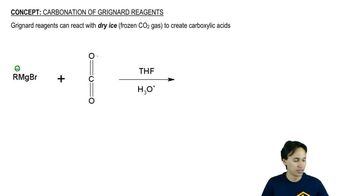Phenol oxidation can be coupled with other reactions to form new C―C bonds using reactions studied previously. Predict the product of the following series of reactions.
(b)
 Verified step by step guidance
Verified step by step guidance Verified video answer for a similar problem:
Verified video answer for a similar problem:


 0:24m
0:24mMaster Intro to Predict the Product with a bite sized video explanation from Johnny
Start learning